|
[Go to TOC]
Module 1 - Introduction to Matter, Energy, and Direct Current
Pages i,
1-1,
1-11,
1-21,
1-31,
1-41,
1-51,
1-61,
2-1,
2-11,
2-21,
3-1,
3-11,
3-21,
3-31,
3-41,
3-51,
3-61,
3-71,
3-81,
3-91,
3-101,
3-111,
3-121, Appendix
I,
II,
III,
IV,
V,
Index
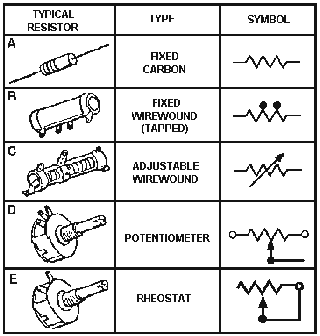
.................. Figure 1-29. - Types
resistors.Q56. What is schematic symbol for a resistor?
Composition Resistors
One the most common types resistors is the molded composition, usually referred
to as the carbon resistor. These resistors are manufactured in a variety sizes and
shapes. The chemical composition the resistor determines its ohmic value and is
accurately controlled by the manufacturer in the development process. They are made
in ohmic values that range from one ohm to millions ohms. The physical size the
resistor is related to its wattage rating, which is the ability resistor to dissipate
heat caused by the resistance.
Carbon resistors, as you might suspect, have as their principal ingredient the
element carbon. In the manufacturer carbon resistors, fillers or binders are added
to the carbon to obtain various resistor values. Examples these fillers are clay,
bakelite, rubber, and talc. These fillers are doping agents and cause the overall
conduction characteristics to change.
Carbon resistors are the most common resistors found because they are easy to
manufacturer, inexpensive, and have a tolerance that is adequate for most electrical
and electronic applications. Their prime disadvantage is that they have a tendency
to change value as they age. One other disadvantage carbon resistors is their limited
power handling capacity.
The disadvantage carbon resistors can be overcome by the use WireWOUND resistors
(fig. 1-29 (B) and (C)). Wirewound resistors have very accurate values and possess
a higher current handling capability than carbon resistors. The material that is
frequently used to manufacture wirewound resistors
1-41
is German silver which is composed copper, nickel, and zinc. The qualities and
quantities these elements present in the wire determine the resistivity the wire.
(The resistivity the wire is the measure or ability the wire to resist current.
Usually the percent nickel in the wire determines the resistivity.) One disadvantage
the wirewound resistor is that it takes a large amount wire to manufacture a resistor
high ohmic value, thereby increasing the cost. a variation the wirewound resistor
provides an exposed surface to the resistance wire on one side. An adjustable tap
is attached to this side. Such resistors, sometimes with two or more adjustable
taps, are used as voltage dividers in power supplies and other applications where
a specific voltage is desired to be "tapped" f.
Q57. What does the wattage rating a resistor indicate?
Q58. What are the two disadvantages carbon-type resistors?
Q59. What type resistor should be used to overcome the disadvantages the
carbon resistor?
Fixed and Variable Resistors
There are two kinds resistors, FIXED and VARIABLE. The fixed resistor will have
one value and will never change (other than through temperature, age, etc.). The
resistors shown in a and B figure 1-29 are classed as fixed resistors. The tapped
resistor illustrated in B has several fixed taps and makes more than one resistance
value available. The sliding contact resistor shown in C has an adjustable collar
that can be moved to tap f any resistance within the ohmic value range the resistor.
There are two types variable resistors, one called a POTENTIOMETER and the other
a RHEOSTAT (see views D and E fig. 1-29.) An example the potentiometer is the volume
control on your radio, and an example the rheostat is the dimmer control for the
dash lights in an automobile. There is a slight difference between them. Rheostats
usually have two connections, one fixed and the other moveable. Any variable resistor
can properly be called a rheostat. The potentiometer always has three connections,
two fixed and one moveable. Generally, the rheostat has a limited range values and
a high current-handling capability. The potentiometer has a wide range values, but
it usually has a limited current-handling capability. Potentiometers are always
connected as voltage dividers. (Voltage dividers are discussed in Chapter 3.)
Q60. Describe the differences between the rheostat connections and those
the potentiometer. Q61. Which type variable resistor should you select
for controlling a large amount current? Wattage Rating When a current is passed
through a resistor, heat is developed within the resistor. The resistor must be
capable dissipating this heat into the surrounding air; otherwise, the temperature
the resistor rises causing a change in resistance, or possibly causing the resistor
to burn out.
The ability the resistor to dissipate heat depends upon the design the resistor
itself. This ability to dissipate heat depends on the amount surface area which
is exposed to the air. a resistor designed to dissipate a large amount heat must
therefore have a large physical size. The heat dissipating capability a resistor
is measured in WATTS (this unit will be explained later in chapter 3). Some the
more common wattage ratings carbon resistors are: one-eighth watt, one-fourth watt,
one-half watt, one watt, and two watts. In some the newer state--the-art circuits
today, much smaller wattage resistors are used. Generally, the type that you will
be able to physically work with are the values given. The higher the wattage rating
the resistor the larger is the physical size. Resistors that dissipate very large
amounts power (watts) are usually wirewound resistors. Wirewound resistors with
wattage ratings up to 50
1-42
watts are not uncommon. Figure 1-30 shows some resistors which have different
wattage ratings. Notice the relative sizes the resistors.
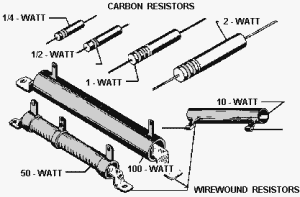
Figure 1-30. - Resistors different wattage ratings.
Standard Color Code System
In the standard color code system, four bands are painted on the resistor, as
shown in figure 1-31.
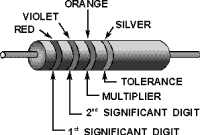
Figure 1-31. - Resistor color codes.
1-43
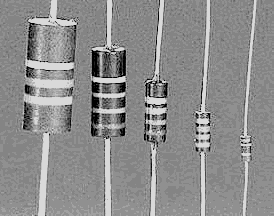
Examples resistor color codes.
The color the first band indicates the value the first significant digit. The
color the second band indicates the value the second significant digit. The third
color band represents a decimal multiplier by which the first two digits must be
multiplied to obtain the resistance value the resistor. The colors for the bands
and their corresponding values are shown in Table 1-1.
Table 1-1. Standard Color Code for Resistors
Use the example colors shown in figure 1-31. Since red is the color the first band,
the first significant digit is 2. The second band is violet, therefore the second
significant digit is 7. The third band is orange, which indicates that the number
formed as a result reading the first two bands is multiplied by 1000. In this case
27 x 1000 = 27,000 ohms. The last band on the resistor indicates the tolerance;
that is, the manufacturer's allowable ohmic deviation above and below the numerical
value indicated by the resistor's color code. In this example, the color silver
indicates a tolerance 10 percent. In other words, 1-44
the actual value the resistor may fall somewhere within 10 percent above and
10 percent below the value indicated by the color code. This resistor has an indicated
value 27,000 ohms. Its tolerance is 10 percent x 27,000 ohms, or 2,700 ohms. Therefore,
the resistor's actual value is somewhere between 24,300 ohms and 29,700 ohms.
When measuring resistors, you will find situations in which the quantities to
be measured may be extremely large, and the resulting number using the basic unit,
the ohm, may prove too cumbersome. Therefore, a metric system prefix is usually
attached to the basic unit measurement to provide a more manageable unit. Two the
most commonly used prefixes are kilo and mega. Kilo is the prefix used to represent
thousand and is abbreviated k. Mega is the prefix used to represent million and
is abbreviated M.
In the example given above, the 27,000-ohm resistor could have been written as
27 kilohms or 7 k . Other examples are: 1,000 ohms = 1 k ; 10,000 ohms
= 10 k ; 100,000 ohms = 100 k . Likewise, 1,000,000 ohms is written
as 1 tab-count: 1"> and 10,000,000 ohms = 10 M. Q62.
A carbon resistor has a resistance 50 ohms, and a tolerance 5 percent. What are
the colors bands one, two, three, and four, respectively?
SIMPLIFYING The COLOR Code. - Resistors are the most common
components used in electronics. The technician must identify, select, check, remove,
and replace resistors. Resistors and resistor circuits are usually the easiest branches
electronics to understand.
The resistor color code sometimes presents problems to a technician. It really
should not, because once the resistor color code is learned, you should remember
it for the rest your life.
Black, brown, red, orange, yellow, green, blue, violet, gray, white - this is
the order colors you should know automatically. There is a memory aid that will
help you remember the code in its proper order. Each word starts with the first
letter the colors. If you match it up with the color code, you will not forget the
code.
Bad Boys Run Over Yellow Gardenias Behind Victory Garden Walls,
or:
Black
-
Bad
Brown
-
Boys
Red
-
Run
Orange
-
Over
Yellow
-
Yellow
Green
-
Gardenias
Blue
-
Behind
Violet
-
Victory
Gray
-
Garden
White
-
Walls
There are many other memory aid sentences that you might want to ask about from
experienced technicians. You might find one the other sentences easier to remember.
There is still a good chance that you will make a mistake on a resistor's color
band. Most technicians do at one time or another. If you make a mistake on the first
two significant colors, it usually is not too
1-45
serious. If you make a miscue on the third band, you are in trouble, because
the value is going to be at least 10 times too high or too low. Some important points
to remember about the third band are:
When the third band is . . . .
Black, the resistor's value is less than 100 ohms. Brown, the resistor's value
is in hundreds ohms. Red, the resistor's value is in thousands ohms.
Orange, the resistor's value is in tens thousands ohms. Yellow, the resistor's
value is in hundreds thousands ohms. Green, the resistor's value is in megohms.
Blue, the resistor's value is in tens megohms or more.
Although you may find any the above colors in the third band, red, orange, and
yellow are the most common. In some cases, the third band will be silver or gold.
You multiply the first two bands by 0.01 if it is silver, and 0.1 if it is gold.
The fourth band, which is the tolerance band, usually does not present too much
a problem. If there is no fourth band, the resistor has a 20-percent tolerance;
a silver fourth band indicates a 10-percent tolerance; and a gold fourth band indicates
a 5-percent tolerance. Resistors that conform to military specifications have a
fifth band. The fifth band indicates the reliability level per 1,000 hours operation
as follows:
Fifth band color
Level
Brown
1.0%
Red
0.1%
Orange
0.01%
Yellow
0.001%
For a resistor whose the fifth band is color coded brown, the resistor's chance
failure will not exceed 1 percent for every 1,000 hours operation.
In equipment such as the Navy's complex computers, the reliability level is very
significant. For example, in a piece equipment containing 10,000 orange fifth-band
resistors, no more than one resistor will fail during 1,000 hours operation. This
is very good reliability. More information on resistors is contained in NEETS Module
19.
Q63. a carbon resistor has the following color bands: The first band is
yellow, followed by violet, yellow, and silver. What is the ohmic value the resistor?
Q64. The same resistor mentioned in question 63 has a yellow fifth band.
What does this signify?
Q65. a resistor is handed to you for identification with the following
color code: the first band is blue, followed by gray, green, gold, and brown. What
is the resistor's value?
1-46
Some resistors, both wirewound and composition, will not use the resistor color
code. These resistors will have the ohmic value and tolerance imprinted on the resistor
itself.
Summary
With the completion this chapter, you now have gained the necessary information
which is the foundation for the further study electricity. The following is a summary
the important parts in the chapter.
In describing the composition matter, the following terms are important for you
to remember:
MATTER is defined as anything that occupies space and has weight.
An ELEMENT is a substance which cannot be reduced to a simpler
substance by chemical means.
A COMPOUND is a chemical combination elements which can be separated
by chemical means, but not by physical means. It is created by chemically combining
two or more elements.
A MIXTURE is a combination elements or compounds that can be
separated by physical means.
A MOLECULE is the chemical combination two or more atoms. In
a compound, the molecule is the smallest particle that has all the characteristics
the compound.
An ATOM is the smallest particle an element that retains the
characteristics that element. An atom is made up electrons, protons, and neutrons.
The number and arrangement these subatomic particles determine the kind element.
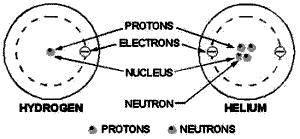
An ELECTRON is considered to be a negative charge electricity.
A PROTON is considered to be a positive charge electricity.
A NEUTRON is a neutral particle in that it has no electrical
charge.
ENERGY in an electron is two types - kinetic (energy motion)
and potential (energy position).
1-47
ENERGY LEVELS the electron exist because the electron has mass
and motion. The motion gives it kinetic energy and its position gives it potential
energy. Energy balance keeps the electron in orbit and should it gain energy it
will assume an orbit further from the center the atom. It will remain at that level
for only a fraction a second before it radiates the excess energy and goes back
to a lower orbit.
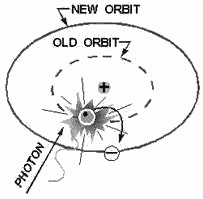
SHELLS and SUBSHELLS electrons are the orbits the electrons
in the atom. Each shell contains a maximum 2 times its number squared electrons.
Shells are lettered K through Q, starting with K, which is the closest to the nucleus.
The shell can be split into 4 subshells labeled s, p, d, and f, which can contain
2, 6, 10, and 14 electrons, respectively.
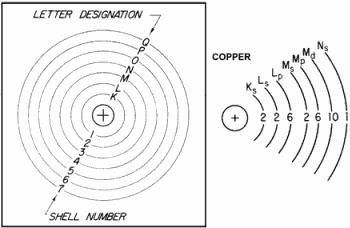
VALENCE an ATOM is determined by the number electrons in the
outermost shell. The shell is referred to as the valence shell, and the electrons
within it are valence electrons. An atom with few valence electrons requires little
energy to free the valence electrons.
IONIZATION refers to the electrons contained in an atom. An
atom with a positive charge has lost some its electrons, and is called a positive
ion. a negatively charged atom is a negative ion.
1-48
Conductors, Semiconductors, and Insulators are categorized as
such by the number valence electrons in their atoms. The conductor normally has
3 or less valence electrons and fers little opposition to the flow electrons (electric
current). The insulator contains 5 or more valence electrons and refers high opposition
to electron flow. The semiconductor usually has four valence electrons conductivity
and is in the midrange. The best conductors in order conductance are silver, copper,
gold, and aluminum.
CHARGED BODIES affect each other as follows: When two bodies
having unequal charges are brought close to each other, they will tend to attract
each other in an attempt to equalize their respective charges. When two bodies,
both having either positive or negative charges, are brought close together, they
tend to repel each other as no equalization can occur. When the charge on one body
is high enough with respect to the charge on an adjacent body, an equalizing current
will flow between the bodies regardless the conductivity the material containing
the bodies.
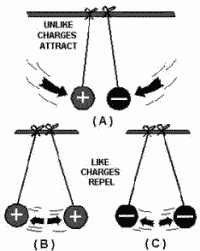
A NEUTRAL BODY may be attracted to either a positively or negatively
charged body due to the relative difference in their respective charges.
CHARGED BODIES will attract or repel each other with a force
that is directly proportional to the product their individual charges and inversely
proportional to the square the distance between the bodies.
1-49
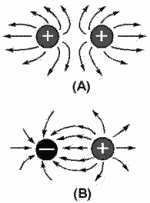
ELECTROSTATIC Lines force are a graphic representation the field
around a charged body. These lines are imaginary. Lines from a positively charged
body are indicated as flowing out from the body, while lines from a negatively charged
body are indicated as flowing into the body.
MAGNETIsM is that property a material which enables it to attract
pieces iron. a material with this property is called a magnet. Any material that
is attracted to a magnet can be made into a magnet itself.
FERROMagnetic MATERIALS are materials that are easy to magnetize;
e.g., iron, steel, and cobalt.
NATURAL MAGNETS, called magnetite, lodestones, or leading stones,
were the first magnets to be studied. Most magnets in practical use are artificial
or man-made magnets, and are made either by electrical means or by stroking a magnetic
material with a magnet.
RELUCTANCE is defined as the opposition a material to being
magnetized.
PERMEABILITY is defined as the ease with which a material accepts
magnetism. a material which is easy to magnetize does not hold its magnetism very
long, and vice versa.
RETENTIVITY is defined as the ability a material to retain magnetism.
A Magnetic POLE is located at each end a magnet. The majority
the magnetic force is concentrated at these poles and is approximately equal at
both poles.
1-50
| - |
Matter, Energy,
and Direct Current |
| - |
Alternating Current and Transformers |
| - |
Circuit Protection, Control, and Measurement |
| - |
Electrical Conductors, Wiring Techniques,
and Schematic Reading |
| - |
Generators and Motors |
| - |
Electronic Emission, Tubes, and Power Supplies |
| - |
Solid-State Devices and Power Supplies |
| - |
Amplifiers |
| - |
Wave-Generation and Wave-Shaping Circuits |
| - |
Wave Propagation, Transmission Lines, and
Antennas |
| - |
Microwave Principles |
| - |
Modulation Principles |
| - |
Introduction to Number Systems and Logic Circuits |
| - |
- Introduction to Microelectronics |
| - |
Principles of Synchros, Servos, and Gyros |
| - |
Introduction to Test Equipment |
| - |
Radio-Frequency Communications Principles |
| - |
Radar Principles |
| - |
The Technician's Handbook, Master Glossary |
| - |
Test Methods and Practices |
| - |
Introduction to Digital Computers |
| - |
Magnetic Recording |
| - |
Introduction to Fiber Optics |
| Note: Navy Electricity and Electronics Training
Series (NEETS) content is U.S. Navy property in the public domain. |
|

















